In the run-up to the 1984 Summer Olympics in Los Angeles, Southern California police agencies were busy getting ready for an invasion of tourists . . . and possibly, an invasion of well-armed terrorists. The cops in the Golden State were determined that the failures of the 1972 Munich Olympics would not be repeated on their turf, so they were eager to upgrade their counterterrorism capabilities.

To help expose police to the latest and greatest technology (and hopefully, generate sales!), the industry held a special weapons exposition in Los Angeles in 1982 and 1983. The so-called “Ordnance Expo” was hosted near the Los Angeles Police Department Academy, as I recall, and if it had anything to do with lethal or nonlethal tools, you could find it there.
My dad, God bless him, knew that my brother and I wouldn’t want to miss it, so he pulled us out of school to attend with him, each year. To say that we enjoyed ourselves as we played with the most sophisticated weapons of the era would be a dramatic understatement! Disneyland, located just a few miles away, may have billed itself as “The Happiest Place On Earth,” but to a young teen with Hoppes #9 in his blood, the Ordnance Expo was the most fun place on Earth!
Terminator sharks
It was at Ordnance Expo that I got my hands on my first laser. The unit was about the size of two bricks, laid end-to-end. It was a little thinner and lighter, but still added a lot of heft to the trim, little American-180 submachine gun that it was mounted to. There was no capability to do live fire there in the exhibit hall, but there was a TV with a videotape playing on a loop which showed the gun dramatically hosing a stream of .22LR—at a brisk 1,200 rounds/minute—towards wherever the red laser was pointed. As I stood there in the booth painting the rafters with the laser-equipped SMG (Rule #2!), I could imagine a river of lead following the beam and I couldn’t help but grin.
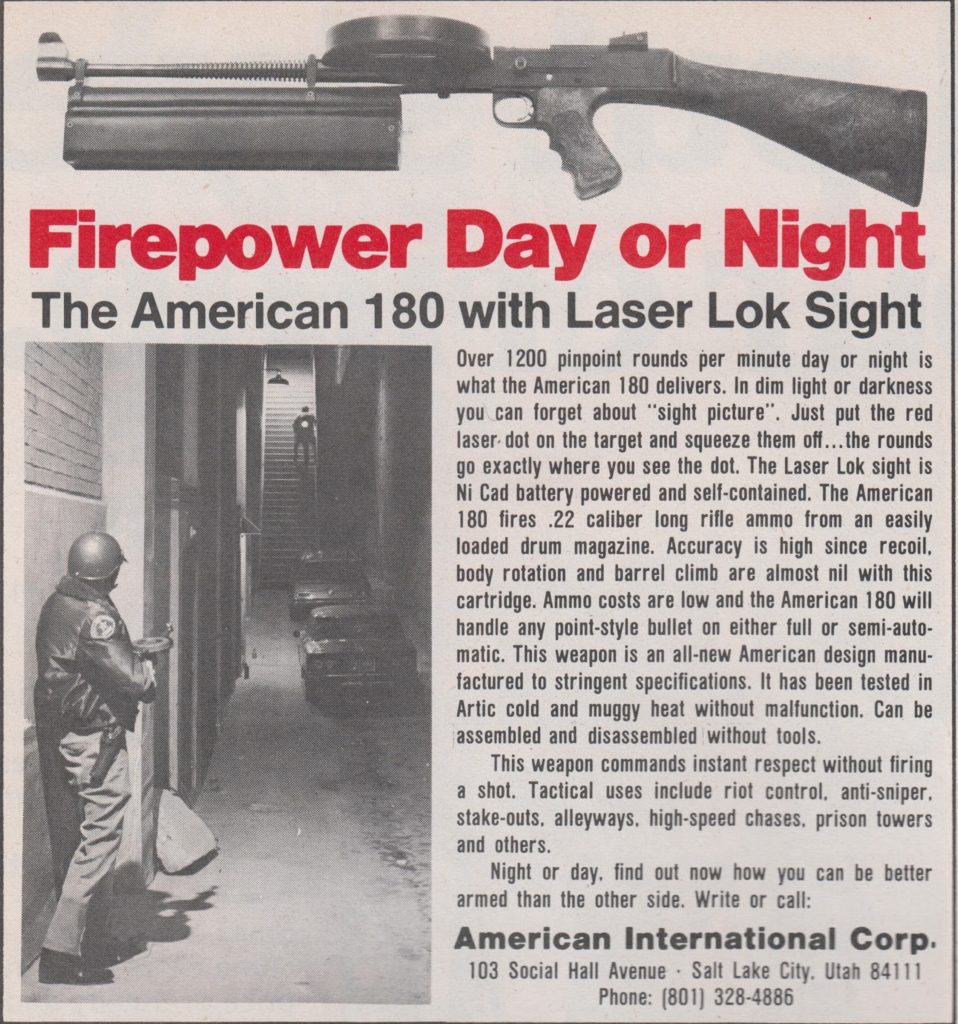
The A-180 laser made the biggest impression, but I remember a few other lasers there at the Expo too, including one about the size of a C-cell Maglite, clamped underneath an HK MP-5. Another sat atop a Colt Trooper, looking like some odd kind of hunting scope1. The Colt had an exaggerated, extended grip to store the battery pack for the unit, which probably had a ridiculously short run time, for all its bulk.
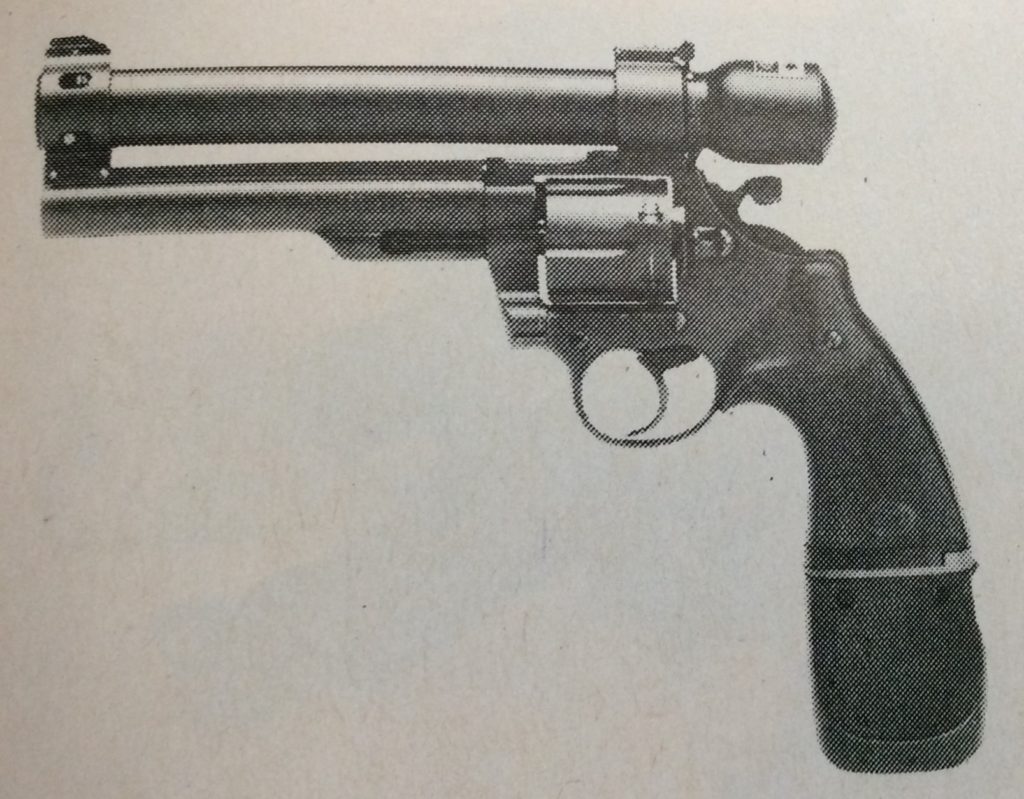
So it was, when Arnold walked into the Alamo Sport Shop a year or two later, and asked to see the “.45 longslide with laser sighting,” I summoned all the cool I could muster to nonchalantly tell my buddies, “yeah, I’ve played with one of those.”
THE CRUTCH
Fast forward to 1996, when a young Crimson Trace launched its line of Lasergrips at the SHOT Show. Technology had advanced at an incredible rate since the early 80s, and the bulky, battery-limited lasers of the past had now been eclipsed by compact units with reasonable battery lives and good handling characteristics. There were a few companies playing with the concept, but the most promising of them was Crimson Trace, and I thought their Lasergrips were the best of the breed.
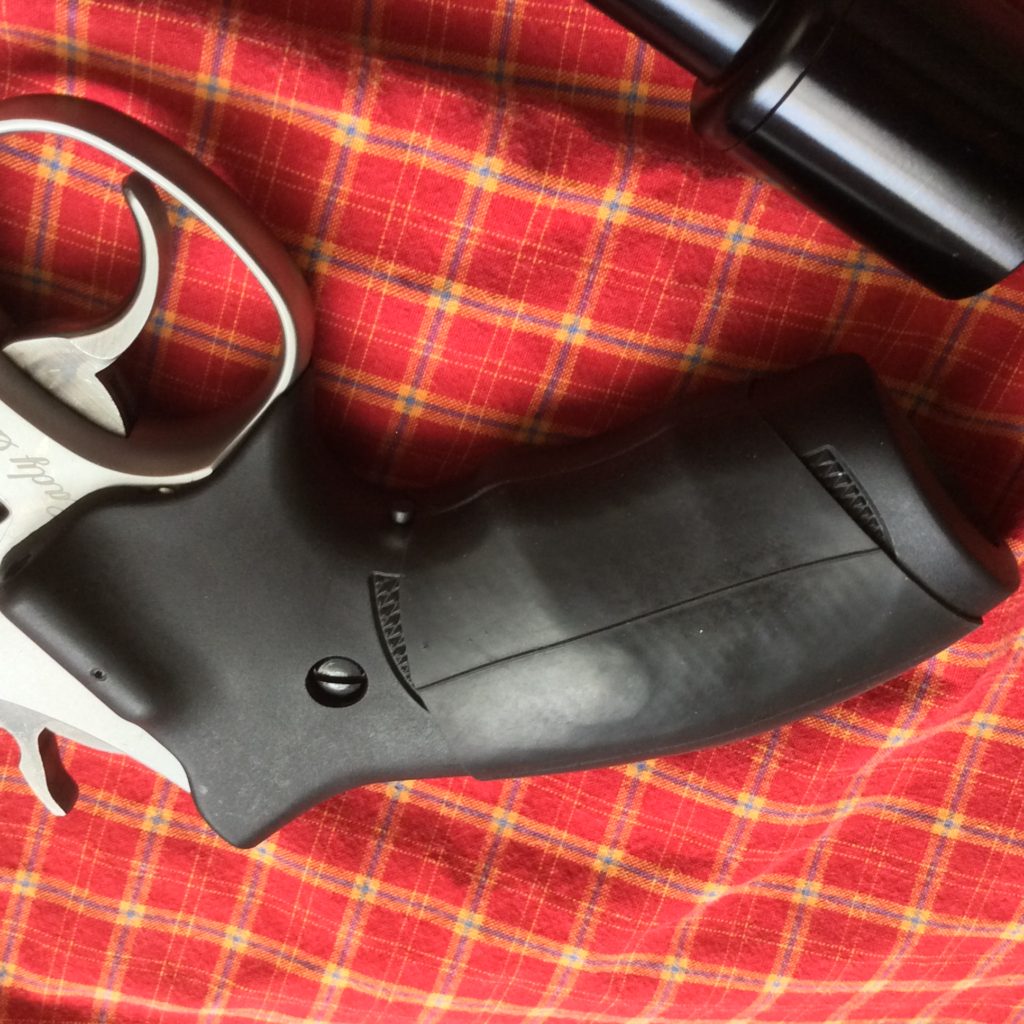
So, I quickly purchased a set for the Smith & Wesson Model 65 that served as our “house gun.” I thought the laser would be a big help for my wife, who was gun safe, but not a highly-trained enthusiast2. I was impressed by the instinctive activation of the Crimson Trace Lasergrips, which only required you to grasp the gun for firing, and did not require any extra moves to flip switches or push buttons (particularly with the trigger finger—yikes!) to make things happen. Just grab the gun, and it comes on. Nothing to forget, and nothing to encourage a negligent discharge. Simple. Neat.
The Lasergrips turned out to be a good purchase. Although my wife shot very well with iron sights, the laser really increased her confidence to get hits, particularly in a dynamic situation. I wasn’t sure if the laser actually changed her ability to hit, but it did change her comfort with the gun, and thus her confidence. I counted that as a win, in itself.

Since the hard plastic grips of those early Lasergrips were mostly smooth, and lacked the cushion and traction of the Pachmayr Compacs they replaced, I stretched a section of bicycle innertube over them to help. It looked funky, but it accomplished the goal, and it’s still there on the gun, decades later.(3)
JUMPING OFF THE FENCE
The experience with the K-Frame Lasergrips was positive, but I didn’t feel a compelling need to equip my J-Frame carry gun with them. I had developed strong habits around the iron sights and could hit well with them, even in the tiny 640, so I didn’t think the laser was a necessary addition. A handful of thoughts eventually persuaded me to give them a try though.
First, while the J-Frame had been my primary carry gun for a long time, changing circumstances at work and home now had me carrying an autopistol almost exclusively. Since most of my training and daily handling had shifted to the square gun, my skills with the J-Frame were starting to atrophy. Therefore, I thought I might benefit from the laser’s help a little more than before.
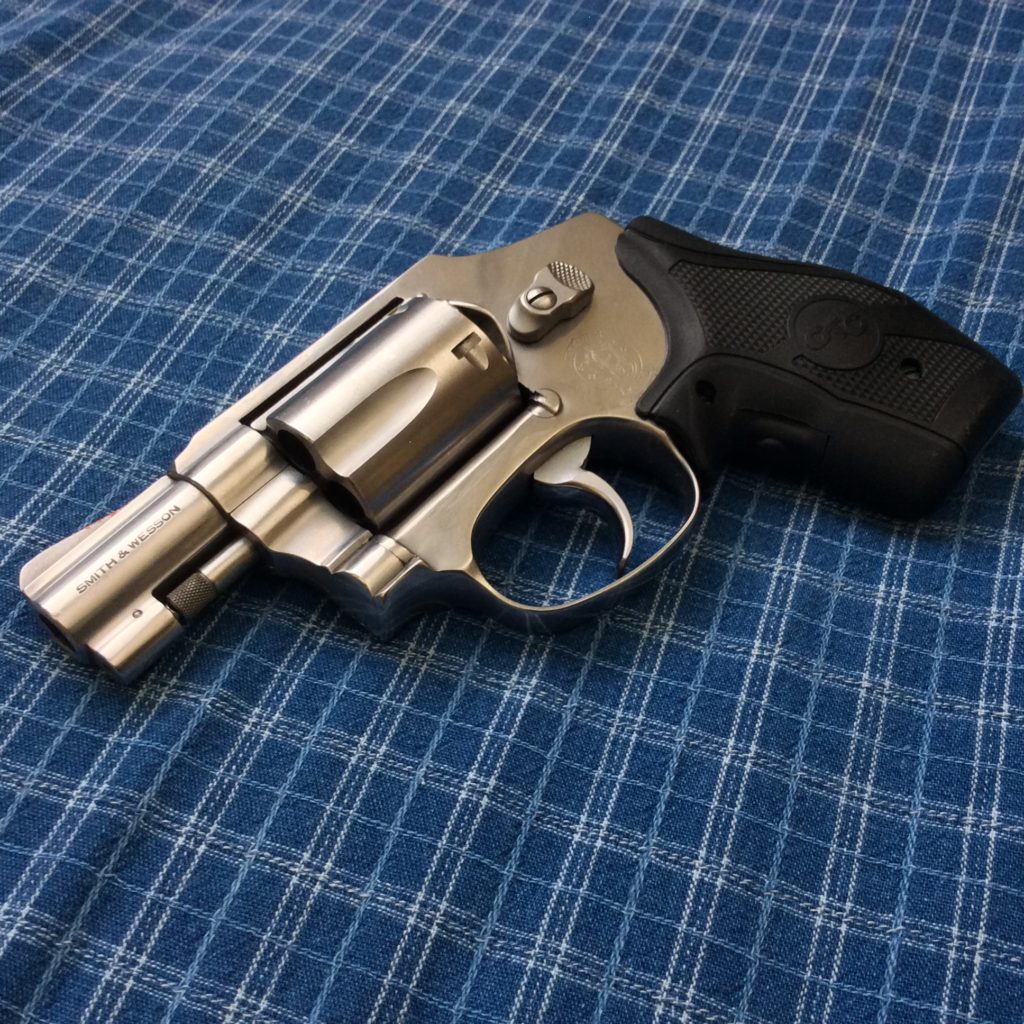
Additionally, after doing some realistic force-on-force training and experiencing the tendency to become target focused under stress, I thought the laser might help to give me a useful index when my lizard brain had me focusing on the threat, and not on my sights.
Also, I’d been paying increased attention to the possibility that I might need to shoot from awkward or compromised positions, and I thought the laser might provide a useful assist. Whether I had to fire after being wounded, after getting knocked to the ground, or from around an awkward piece of cover, I thought the laser might make the job easier.
Lastly, and quite importantly, the financial barrier had been lowered by a new professional discount which reduced the cost considerably. While the grips would still be fairly expensive, the discounted price was friendly enough that I could take the risk of experimenting with them. If I didn’t like them, I figured I could sell them and recover most of the cost.
Two’s In!
So, I took the plunge and purchased the Crimson Trace LG-405 Lasergrip for my faithful snubby. Although Crimson Trace made a model with a larger grip that would give me increased control of the little blaster, I stuck with the “boot grip” style, because the gun lived in my pocket.
In the years since my purchase of that early set of K-Frame Lasergrips, Crimson Trace had upped their game by adding overmolded versions, with a soft rubber layer over the hard plastic frame. On many models, the entire grip surface was covered, but on the LG-405, the overmold was selective. Soft rubber material was present on part of the back strap and on the front strap, but the heel of the gun was left uncovered (exposing the round butt frame), and the side panels remained hard plastic.
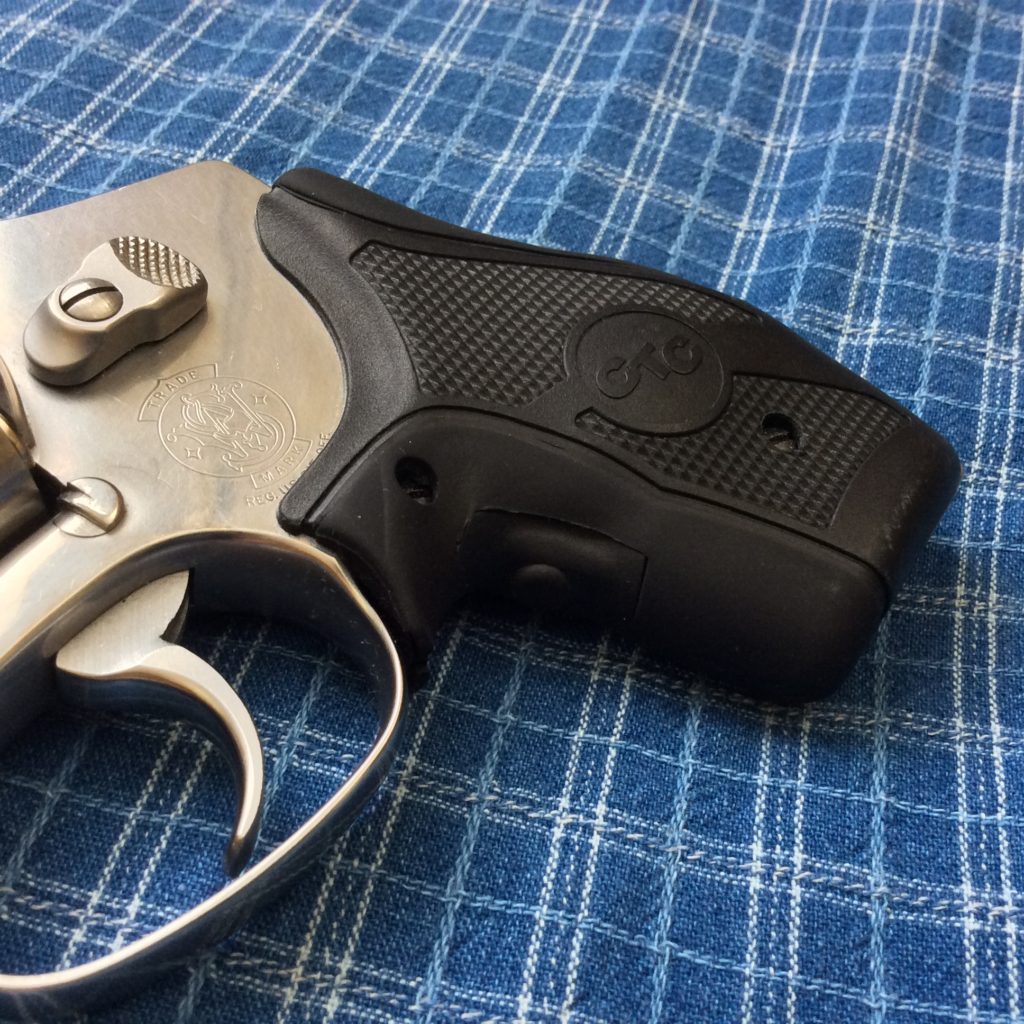
This had two highly desirable effects. First, the web, palm, and fingers of the shooting hand were given some much-appreciated cushion from the recoil of the potent +P and +P+ loads that I was shooting in the gun. The strap of soft rubber that stretched across the back strap, just under the recoil hump, was designed as a crushable pocket that ate up some of the recoil energy. It worked great, and was a very useful addition to the grips.
The other benefit of the partial overmold was the reduced friction. Unlike most other rubber grips, the side panels and frame heel remained slick, and didn’t grab clothing while being carried or drawn. This made for smoother presentations, and less issues with printing.
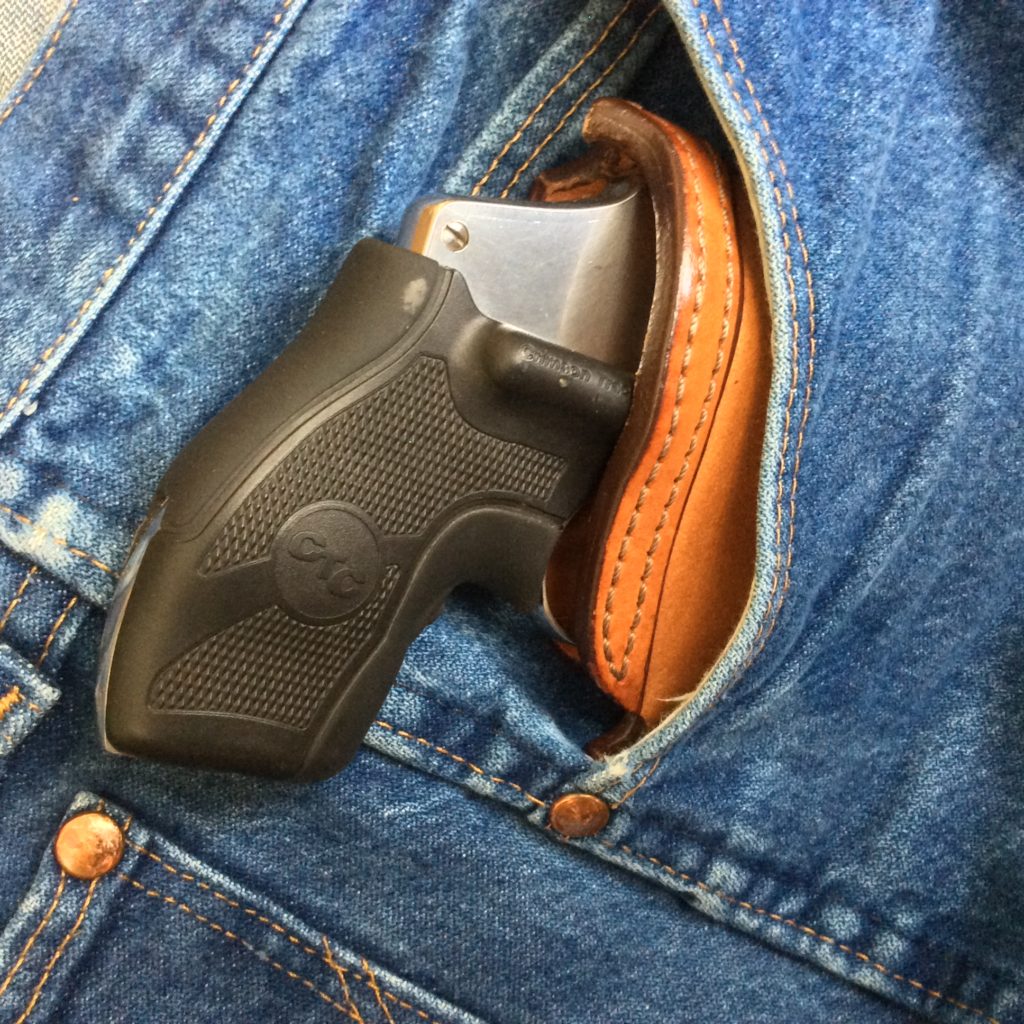
The LG-405 grips carried great in a pocket, were comfortable to carry and shoot, helped the gun to point naturally, and felt good in my hand. The design of these boot grips was so good, that I found myself thinking that Crimson Trace should market a non-laser version, so more shooters could enjoy them.
LIFE WITH THE LASER
There are many arguments for having a laser on your gun, and I think many of them have merit. I’ll be honest though, and will confess that I rarely use the laser as an aiming device during my practice, opting instead to continue my iron sight habits for the vast majority of my shooting.
It’s not that the laser doesn’t work. It can certainly help you to direct your fire, but I’m just more comfortable working with the irons and want to maintain my skills with them, so they get the concentrated effort. I’m happy to have the laser there as a supplement to the irons, but don’t want to make them my primary sighting aid, so I use them sparingly in training.
Despite the fact that I’m not a “laser guy,” my experience working with the laser has taught me a few things about this tool.
The laser can slow you down. There’s a tendency for people like me, who are not highly practiced or skilled with the laser, to delay taking a shot while you wait for the laser to settle down. Because the laser makes the gun’s movement highly visible, a shooter can find himself taking extra time to dampen the movement before pulling the trigger, even when he would have been content with the apparent quality of the iron sight picture. In this sense, the laser is similar to an optic, in that it appears to exaggerate your movement, even though it doesn’t—you’re just seeing it better.
There’s also a delay inherent to reacquiring the laser dot after the gun recoils—it can take more time to locate and settle the small dot than it does to index the larger, cruder, iron sights. This can be improved through training and experience, as a legion of accomplished red dot shooters have proven, but I still think most shooters will be faster with irons at typical handgun distances than they will be with lasers. Karl Rehn’s interesting research shows this advantage may be less than I perceived, but still tends to reinforce the irons as a faster option for most people;
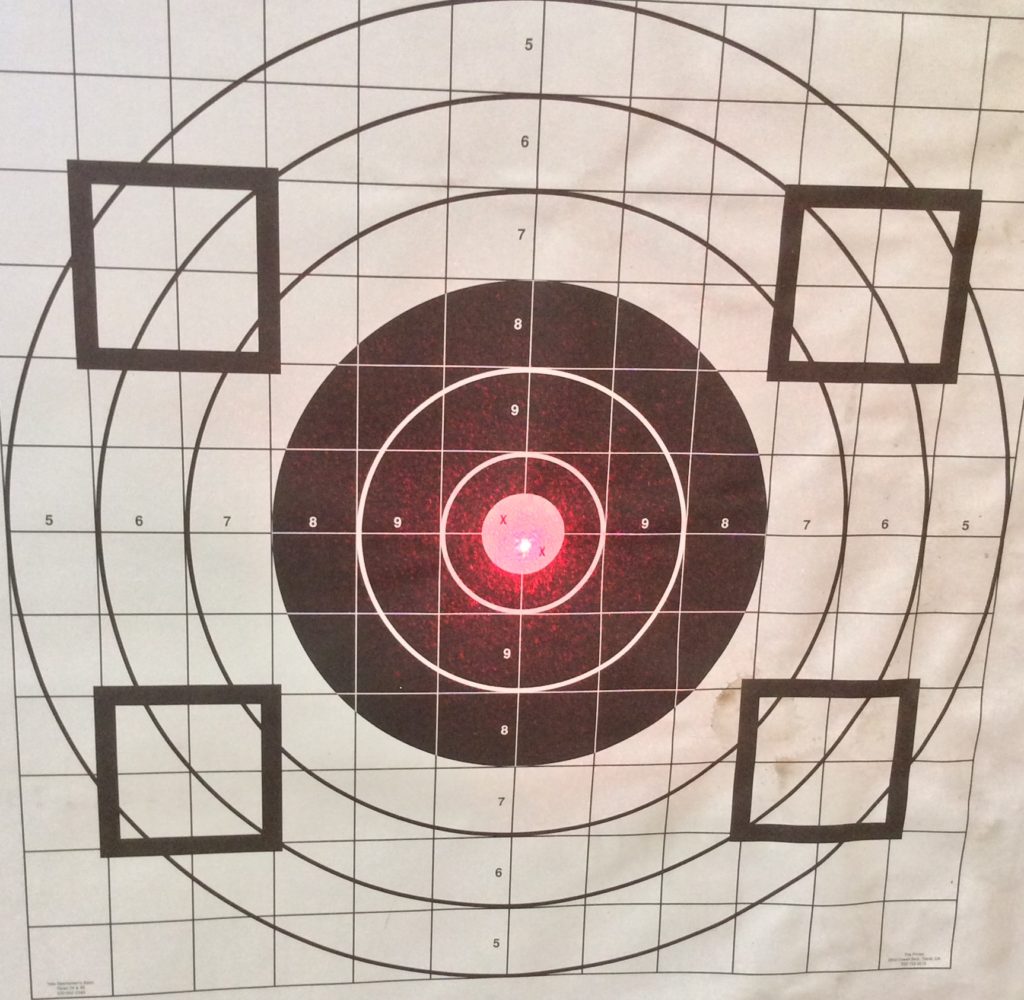
The laser has limits. Red lasers like mine can be hard to see at distance or in daylight conditions, making their use impossible in many shooting situations. The new, green lasers (which were not available when I made my purchase many years ago) are much better in this regard, and battery technology is catching up with the green laser’s increased energy demands, so they’re a better choice for most applications. Even so, as ranges increase and daylight burns brighter, the green dots can get washed out too, so you can’t afford to abandon your iron sight skills and habits;(4)
-Right handers might block the dot. Due to the fact that cylinder releases are almost universally located on the left side of the gun, the laser module goes on the right side of the frame, to prevent interference with that critical control. Unfortunately, this means that right handers with good trigger finger habits will frequently block the laser’s beam when the trigger finger is in register on the side of the gun. If you’re justified in taking a threat at gunpoint, but are not ready to shoot yet, your laser may not be visible because your finger’s in the way. Once again, your iron sight habits have to be maintained. On a positive note, the right side laser housing makes a great thumb shelf when you’re shooting with your left hand, and may aid your control of the gun;
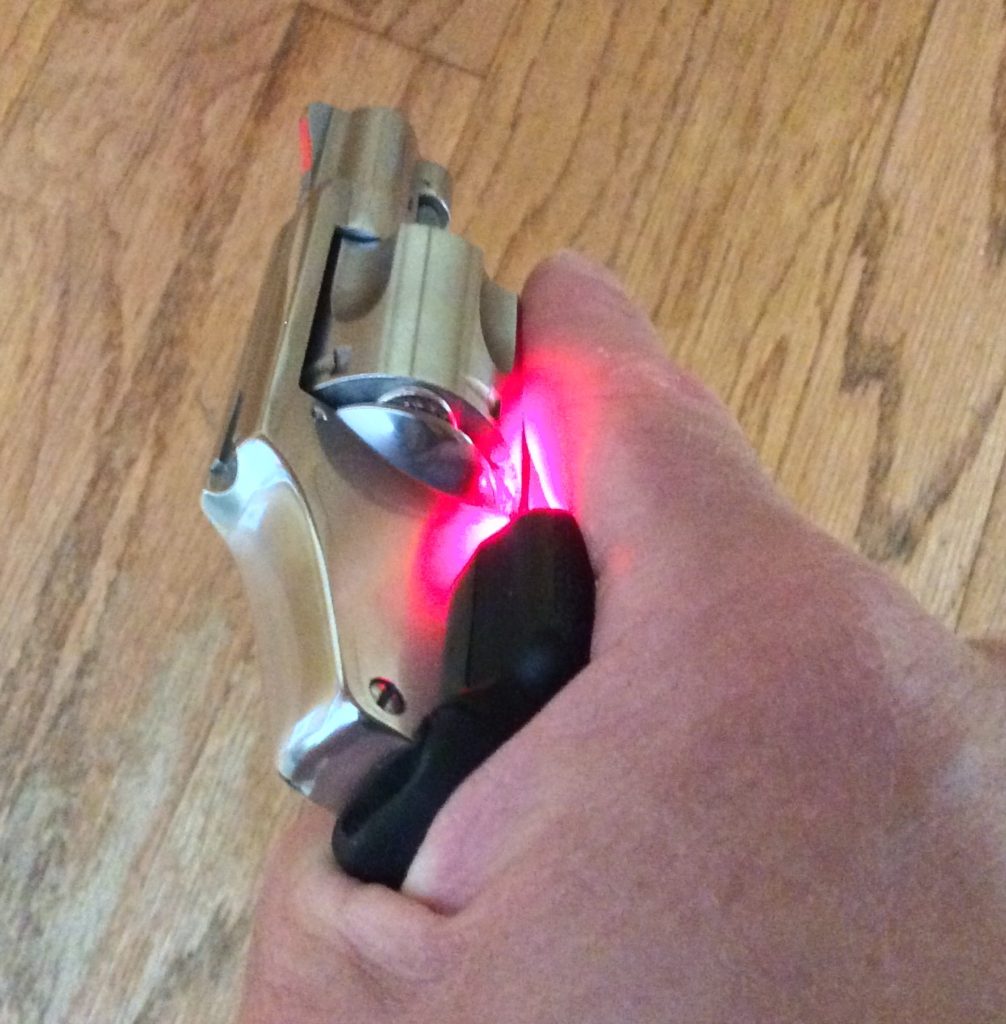
-Consider a parallel alignment. Since the laser module is mounted on the right side of the gun, and below the bore axis, Crimson Trace angles the laser’s beam slightly up and to the left, so that it intersects the bore line at 50 feet from the muzzle. If you shoot at a target inside of 50 feet, the laser will print low and to the right of the point of impact (by decreasing amounts, as you near 50 feet), and if you shoot beyond 50 feet, the laser will print increasingly high and to the left of the point of impact. At the short distances most handguns are fired at, the difference is negligible and can be ignored, but I still prefer a little more consistency from the laser. As such, I adjusted my laser so that the beam is parallel to the bore axis in both elevation and azimuth. In this manner, it always points about 1” below and about a half-inch to the right of where the bullet will impact, regardless of distance. Whether I’m shooting near or far, across a room or across a parking lot, the bullet will always land about 1” higher and a half-inch to the left of the laser dot, if I do my part. I think that makes life simpler, and I’m all for that;
-The laser adds capability. Although I normally don’t notice the presence of the laser dot when I’m shooting, I have found it to be particularly helpful when shooting from those awkward and broken positions I mentioned earlier. In “downed officer” drills, or when shooting behind awkward cover (i.e., under a car), the laser is a useful tool. It’s also helpful in low light, when your irons may not be as visible as you’d like them to be;
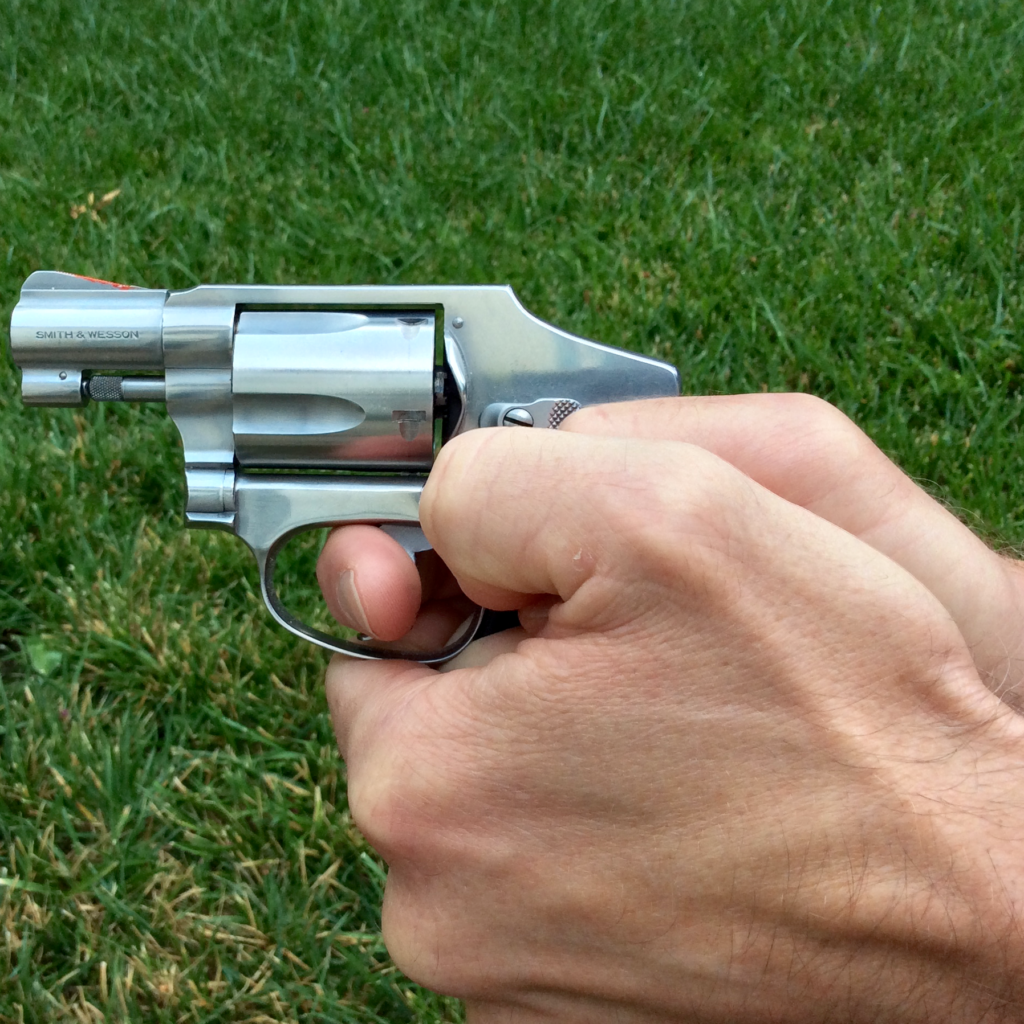
–Lasers might improve with age. When I first bought the LG-405 Lasergrips, I wasn’t suffering from presbyopia yet, but over a decade later my aging eyes are having a harder time getting that front sight in focus (sometimes the best I can do is “less fuzzy”), and I see a potential for the laser to become increasingly helpful as a sighting aid as time goes by. I think a reflex (“red dot”) sight would be an even better long term solution for “middle age eye disease,” but that’s not a practical solution for most revolvers yet—and particularly the J-Frame-sized guns—so the laser is the next best technology to consider. I’m not ready to make the laser my primary aiming device, but it’s nice to have the extra help, and there may come a time when it assumes a more important role for me—thankfully, not yet, but maybe someday.
FINAL THOUGHTS
The genesis for this article was an inquiry from one of our fantastic RevolverGuy readers, who asked me why I preferred the LG-405 Lasergrip on my 640, and wondered if I would recommend them.
By now, you’ve probably surmised that while I find the laser to be a helpful addition, it’s not a deal-breaker for me. I could get by without the laser and not suffer much for it. I would certainly lose some capability at the margins, but I think I’d probably be OK in most circumstances without the help of the laser.

However, I would really miss the grip itself! I’ve found the LG-405 grip to be an excellent take on the boot grip concept, and really appreciate the hybrid design which incorporates hard panels on the sides and soft material fore and aft. The grips are highly compact, very comfortable, don’t grab the clothing, and anchor in the hand well. The soft rubber channel at the back eases felt recoil and makes the gun point well. The soft rubber on the front strap helps to protect my fingers from the +P beating they used to take with my wood boot grips, and helps to control the pocket blaster. The only thing I could recommend to improve them would be to offer a green laser option—a LG-405G model would be spiffy, and much more capable. Hopefully Crimson Trace is reading this.
Considering the MSRP on a set of LG-405 Lasergrips is almost as much as the street price of a brand new S&W 642, I don’t know if I’m ready to recommend them on the basis of the grip features alone, but it helps a bit to know that you’re getting more than just a laser when you’re paying the tab. But you wouldn’t pay MSRP, would you? The good folks at Optics Planet will cut that down by a third and make it even easier to pull the trigger. For a little over $200, they’ll sell you a great set of boot grips with a laser. Is that worth it? Only you can decide.
I will say this: If the laser unit broke on my grips and couldn’t be fixed, I’d still carry them. I like them that much.
Now, I wouldn’t pay $200+ for them without the added value of the laser, but in a world where a movie ticket is almost $20 and people pay upwards of $10 for a cup of hot water filtered through ground cocoa beans, paying a couple Benjamins for a good set of boot grips with a laser—and free batteries for life— doesn’t seem that outlandish to me.
I’m happy to have the extra help when I need it, and think that’s worth the price of admission, but you’ll have to do your own calculus.
God bless, and be safe out there.
Did This Content Help You in Some Way? Support RevolverGuy on Patreon!
ENDNOTES
1. The gun I remembered was John Matthews’ Model 7, which mounted a miniaturized laser in an 8” long, 1 3/8” O.D. protective tube on top of a 6” Colt Trooper. The electronics were contained in the walnut grip, and a nickel-cadmium battery pack—which purportedly gave 20 minutes of run time—was screwed to the base of the grip. Matthews’ Laser Products Corporation morphed into the company all of you know as Surefire, today (information and image from the 1985 Guns & Ammo Annual);
2. In the military, we referred to people like my wife as “non-dedicated personnel,” or NDPs. NDPs didn’t normally carry weapons, but might have a requirement to be armed for their defense in certain environments or on certain missions. In the service, NDPs receive familiarization training with their assigned weapons, but not the more comprehensive training that members of the combat arms specialties receive.
As RevolverGuys, we tend to fall into the enthusiast category, and pursue advanced levels of training, skill and readiness. We would like more gun owners to join us in that quest—particularly our loved ones—but the honest truth is that most gun owners are NDPs and plan to stay that way. The challenge for us, as their coaches, instructors and mentors, is to meet them where they’re at, and deliver appropriate assistance and education for their level of interest, skill, commitment, and experience. We can try to nurture them and encourage them to become more skilled and experienced shooters over time, but it’s important to respect the boundaries they set, and tailor our efforts accordingly. Expectations and standards are tied to commitment, and you can’t push a rope!
3. Hogue would soon market a more refined version of this idea—the HandALL grip sleeve—with great success. For the record, the innertube mod wasn’t my own clever idea—I’d seen it used on an early Glock in one of the gunzines (back before Al Gore’s internet became a “thing,” that’s how we got information), and thought it was just the ticket for the slick Crimson Trace Lasergrips. I guess Hogue was reading the same magazines, and figured they could do one better. I kinda like the innertube though—there’s no finger grooves in the wrong place, it’s inexpensive, and it just works. Plus, the younger kids at the range say it looks ”old school”—like I’m the “O.G. of the L.G.” ; ^ )
4. I experienced this with a few green laser-equipped guns at SHOT Show this year. When you’re under sunny skies, even the green lasers can struggle to be visible at distances beyond 15 yards or so. Take advantage of the laser, but don’t become dependent on it!

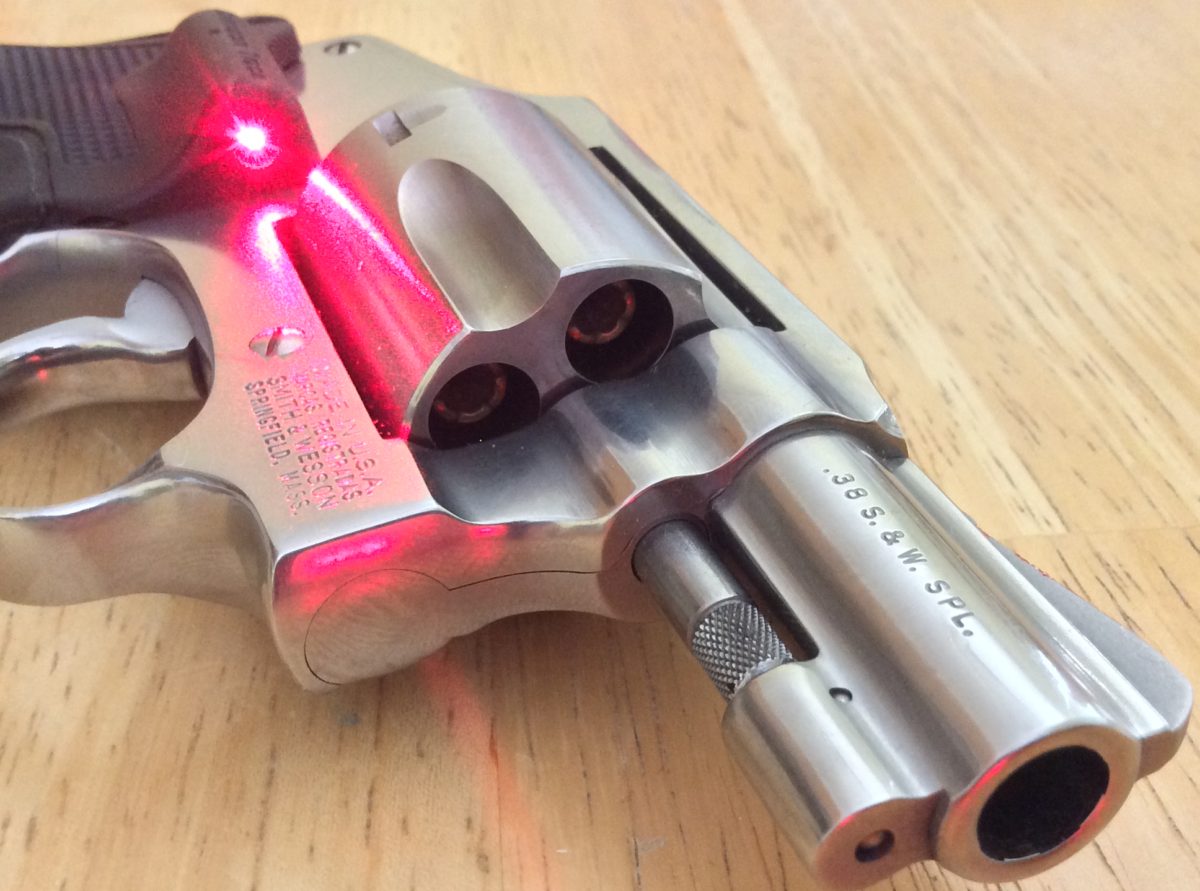
Though I don’t use one on duty. They DO have their niche. I was sold when I bought my LCP with an integral laser. Very useful in low light. Good article. Thanks and keep up the good work.
Mike,
Another excellent article, thank you.
Another Mike (not Mike Wood thanking himself)
Thanks Another Mike! Glad you enjoyed it!
From the other Mike.
I’m not authorized lasers on my weapons! BLAARGH! However, I had no idea someone made a .22LR machine gun… Fascinating! You could actually afford the ammo to shoot it without taxpayer support!
I’d love to have one of those A180s! Can you imagine the fun of hosing down a bunch of plastic soda bottles with a stream of .22s? I understand the drums can be a little finicky at times, but I’d put up with that for the fun.
You ought to see the 22 caliber Gatlings fire. Nothing but smoke and fire!
Mike, thanks for another really great article! My interest in lasers has never been very strong after shooting a friend’s Beretta 92 that was equipped with one in the mid-90s. I always felt their best application was on carbines and sub-machine guns. Now that I’m north of 50 and I carry a 642 and SP101 almost exclusively, I might consider giving that boot grip CT a try!
Ian, you might really enjoy them on the revolvers. The 92F has a large grip to begin with, and adding a fatter LaserGrip can really make the package a little too much of a handful–kind of like when I tried an early set of Pachmayrs on my Sig P226 (they came right off and went back to the store). The LaserGrips for the revolvers are shaped closer to the original dimensions and are very comfortable in the hand.
Great write up, Mike.
As usual, Mike, you provide a fine historical perspective on a tool I keep on my Taurus 85, a gun definitely worth less than the grips! It is now the “tackle box gun” that goes in my fishing vest or out in the garden where the Copperheads turn up too often. I have shot three this year with revolver snake shot, and the CT let me site in on the coils in very low light of our chicken coop. Like you, though, I use the irons but the last, in such cases, gets me in the ballpark.
We may upgrade my pocket-carry gun, a Kimber K6S, to the boot version of the CT grip, now that they have the combination hard/soft grip out.
Yes, I’ve seen a hybrid with wood and polymer, and it looks sharp.
All the laser grips I’ve tried have been either too long or too short. I won’t say lasers are bad, or fault anyone who uses them, but they’re not for me right now.
I have been a fan of Crimson Trace products since the beginning. That means I own an use some that are many years old. I now use both laser grips and laser guard models I have them on every handgun I carry for EDC. I pay little or no attention to the laser anytime I can see my sights. But the red laser is worth its weight in gold in any low or no light situation. For that reason, all my lasers are red. They don’t replace my sights but they very positively supplement them when I can’t see the sights.
I also like the shape and texture of the lasergrip models available today. Much better than the old hard plastic models. I personally will not be without the Crimson Trace red laser for any of my personal protection handguns. My wife loves them too!
Kenneth, thanks for the great testimony! I’m glad you’re getting so much out of them. I’m curious . . . do you have a hard time finding holsters for your pistols with the LaserGuard attached?
I wouldn’t use them as an illumination device (that’s what a white light is for), but I’ve found that the red lasers are sufficiently bright enough to light up a dark room—at least enough to see a person in there.
I’ve had a lot of Concealed Carry students come in with lasers on their gun; some were experienced shooters, but most seem to have been new to the gun world, and let a Gun Shop Bubba convince them they needed it. It’s easy to tell who practices with them; the ‘practiced’ ones, when they cover the beam with their finger, just put the sight on the target, and when the little red spot appears when they move to the trigger, they just take it in stride and do their shooting. The newbies, or non-practicers, will stop and check their gun, looking for the little red spot. For most of them, it’s a learning experience.
I’ve never gotten to shoot with one, but have played with them in the store. If Momma was to buy me one for my EDC (Christmas is coming…..), I’d put it on and learn to shoot with it. I’m with Ian, I’d like to try one on a carbine. Might be useful when Bambi or Porky come into range in the last 10 minutes of legal shooting time on a cloudy evening. Or maybe a green one on a .22 for shooting at Western Kansas jackalopes as they run across the field. Ace